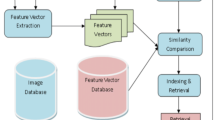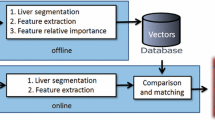Abstract
The most critical step in content-based medical image retrieval systems is feature extraction. The objective of the feature-extraction phase is to discriminate between different types of lesions. Preparing useful features improves diagnosis by an image retrieval system and successful treatment. We propose a new set of geometrical features based on the description of different types of tumors and integrate them with textural elements to enhance the discrimination of five kinds of focal liver lesions. The abnormal region is divided into three sections, including central, middle, and border regions. The textural features are obtained in each part individually, while the geometrical characteristics are calculated for the whole zone of a lesion. Evaluation of the results shows an improvement of prec@6 and mAP, which is attributed to the proposed geometric characteristics. Moreover, our method increases prec@6 by 3.9% compared to recent researches.
Access this chapter
Tax calculation will be finalised at checkout
Purchases are for personal use only
Similar content being viewed by others
References
Costa, M.J., Tsymbal, A., Hammon, M., Cavallaro, A., Suhling, M., Seifert, S. et al.: A discriminative distance learning–based CBIR framework for characterization of indeterminate liver lesions. In: MICCAI International Workshop on Medical Content-Based Retrieval for Clinical Decision Support 2011 Sep 22, pp.92–104 (2012)
Yu, M., Lu,, Z., Feng, Q.,Chen, W.: Liver CT image retrieval based on non-tensor product wavelet. In: International Conference of Medical Image Analysis and Clinical Application (MIACA), pp. 67–70 (2010)
Lei, B., Yang, P., Zhuo, Y., Zhou, F., Ni, D., Chen, S., Xiao, X., Wang, T.: Neuroimaging retrieval via adaptive ensemble manifold learning for brain disease diagnosis. IEEE J. Biomed. Heal. Inform. 23(4), 1661–1673 (2019)
Gu, Y., Yang, J.: Densely-connected multi-magnification hashing for histopathological image retrieval. IEEE J. Biomed. Heal. Inform. 23(4), 1683–1691 (2019)
Veerashetty, S., Patil, N.B.: Manhattan distance-based histogram of oriented gradients for content-based medical image retrieval. Int. J. Comput. Appl. 1–7 (2019)
Mirasadi, M.S., Foruzan, A.H.: Content-based medical image retrieval of CT images of liver lesions using manifold learning. Int. J. Multimed. Inf. Retr. 8(4), 233–240 (2019)
Swati, Z.N.K., Zhao, Q., Kabir, M., Ali, F., Ali, Z., Ahmed, S., Lu, J.: Content-based brain tumor retrieval for mr images using transfer learning. IEEE Access 7, 17809–17822 (2019)
Roy, S., Chi, Y., Liu, J., Venkatesh, S.K., Brown, M.S.: Three-dimensional spatiotemporal features for fast content-based retrieval of focal liver lesions. IEEE Trans. Biomed. Eng. 61(11), 2768–2778 (2014)
Chi, Y., Zhou, J., Venkatesh, S.K., Tian, Q., Liu, J.: Content-based image retrieval of multi-phase CT images for focal liver lesion characterization. Med. Phys. 40(10) (2013)
Yang, W., Lu, Z., Yu, M., Huang, M., Feng, Q., Chen, W.: Content-based retrieval of focal liver lesions using bag-of-visual-words representations of single- and multi-phase contrast-enhanced CT images. J. Dig. Imag. 25(6), 708–719 (2012)
Xu, Y., Lin, L., Hu, H., Wang, D., Liu, Y.: A retrieval system for 3D multi-phase contrast-enhanced CT images of focal liver lesions based on combined bags of visual words and texture words. In: 9th International Congress on Image and Signal Processing, BioMedical Engineering and Informatics(CISP-BMEI), pp. 806–810 (2016)
Wang, J., Han, X.H., Xu, Y., Lin, L., Hu, H., Jin, C.: Tensor sparse representation of temporal features for content-based retrieval of focal liver lesions using multi-phase medical images. In: IEEE International Symposium on Multimedia, pp. 507–510 (2017)
Xu, Y., Lin, L., Hu, H., Wang, D., Zhu, W., Wang, J., et al.: Texture-specific bag of visual words model and spatial cone matching-based method for the retrieval of focal liver lesions using multi-phase contrast-enhanced CT images. Int. J. Comput. Assist. Radiol. Surg. 13(1), 151–164 (2018)
Alahmera, H., Ahmeda, A.: Computer-aided classification of liver lesions from CT images based on multiple ROI. Proc. Comput. Sci. 90, 80–86 (2016)
Napel, A., Beaulieu, F., Rodriguez, C., Cui, J., Xu, J., Gupta, A., et al.: Automated retrieval of CT images of liver lesions on the basis of image similarity. Radiology 256(1), 243–252 (2010)
Qian, Y., Gao, X., Loomes, M., Comley, R., Barn, B., Hui, R. et al.: Content-based retrieval of 3D medical images. In: The Third International Conference on eHealth, Telemedicine, and Social Medicine. eTELEMED, pp. 7–12 (2011)
Spanier, A.B., Caplan, N., Sosna, J., Acar, B., Joskowicz, L.: A fully automatic end-to-end method for content-based image retrieval of CT scans with similar liver lesion annotations. Int. J. Comput. Assist. Radiol. Surg. 13(1), 165–174 (2018)
Tuyet, V., Hien, N., Quoc, P., Son, N., Binh, N.: Adaptive content-based medical image retrieval based on local features extraction in shearlet domain. EAI Endorsed Trans. Context. Syst. Appl. 6(17), 159351 (2019)
Liang, D., Lin, L., Hu, H., Zhang, Q., Chen, Q., lwamoto, Y. et al.: Combining convolutional and recurrent neural networks for classification of focal liver lesions in multi-phase CT images. In: Frangi, A., Schnabel, J., Davatzikos, C., Alberola-López, C., Fichtinger, G. (eds.) Medical Image Computing and Computer-Assisted Intervention—MICCAI 2018. MICCAI 2018, Lecture Notes in Computer Science, LNCS7951, pp.666–675 (2018). Springer
Cai, Y., Li, Y., Qiu, C., Ma, J., Gao, X.: Medical image retrieval based on convolutional neural network and supervised hashing. IEEE Access 7, 51877–51885 (2019)
Owais, M., Arsalan, M., Choi, J., Park, K.R.: Effective diagnosis and treatment through content-based medical image retrieval (CBMIR) by using artificial intelligence. J. Clin. Med. 8(4), 462 (2019)
Trojachanec, K., Kitanovski, I., Dimitrovski, I., Loshkovska, S.: Longitudinal brain MRI retrieval for Alzheimer’s disease using different temporal information. IEEE Access 6, 9703–9712 (2017)
Chi, Y., Zhou, J., Venkatesh, S.K., Huang, S., Tian, Q., Liu, J.: Computer aided focal liver lesion detection. Int. J. Compt. Assist. Radiol. Surg. 8(4), 511–525 (2013)
Radiology Assistant. https://radiologyassistant.nl/abdomen/liver/common-liver-tumors. Accessed 18 June 2020
Hodler, J., Kubik-Huch, R.A., von Schulthess, G.K.: Diseases of the Abdomen and Pelvis 2018–2021: Diagnostic Imaging, IDKD Book. Springer Nature (2018)
Foruzan, A.H., Chen, Y.-W.: Improved segmentation of low-contrast lesions using sigmoid edge model. Int. J. Comput. Assist. Radiol. Surg. 11(7), 1267–1283 (2016)
Esfandiarkhani, M., Foruzan, A.H.: A generalized active shape model for segmentation of liver in low-contrast CT volumes. Comput. Biol. Med. 82, 59–70 (2017)
Foncubierta-Rodríguez, A., Seco de Herrera, A.G., Müller, H.: Medical image retrieval using bag of meaningful visual words: unsupervised visual vocabulary pruning with PLSA. In: Proceedings of the 1st ACM International Workshop on Multimedia Indexing and Information Retrieval for Healthcare, pp. 75–82 (2013)
Acknowledgements
Authors would like to thank Prof. Hongjie Hu in Sir Run Run Shaw Hospital, Medical School, Zhejiang University, for providing us CT data and advice on data processing. This research was supported in part by the Grant-in-Aid for Scientific Research from the Japanese Ministry for Education, Science, Culture and Sports (MEXT) under the Grant No. 18H03267.
Author information
Authors and Affiliations
Corresponding author
Editor information
Editors and Affiliations
Rights and permissions
Copyright information
© 2021 The Author(s), under exclusive license to Springer Nature Singapore Pte Ltd.
About this paper
Cite this paper
Moslehi, S., Foruzan, A.H., Chen, YW., Hu, H. (2021). Content-Based Retrieval of Focal Liver Lesions Using Geometrical and Textural Features of Multi-Phase CT-Scan Images. In: Chen, YW., Tanaka, S., Howlett, R.J., Jain, L.C. (eds) Innovation in Medicine and Healthcare. Smart Innovation, Systems and Technologies, vol 242. Springer, Singapore. https://doi.org/10.1007/978-981-16-3013-2_21
Download citation
DOI: https://doi.org/10.1007/978-981-16-3013-2_21
Published:
Publisher Name: Springer, Singapore
Print ISBN: 978-981-16-3012-5
Online ISBN: 978-981-16-3013-2
eBook Packages: Intelligent Technologies and RoboticsIntelligent Technologies and Robotics (R0)




